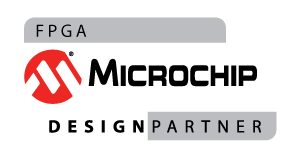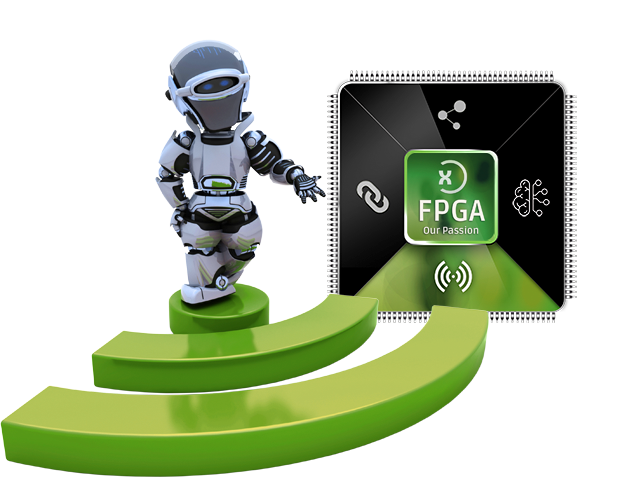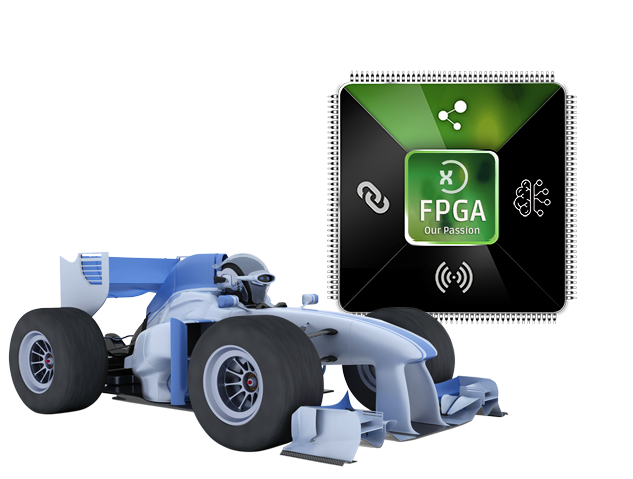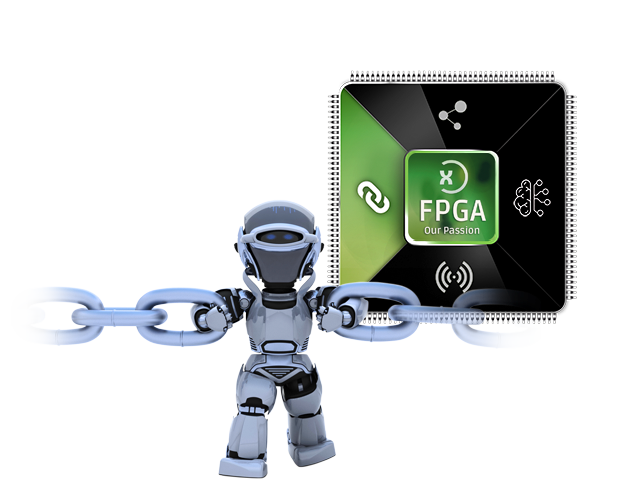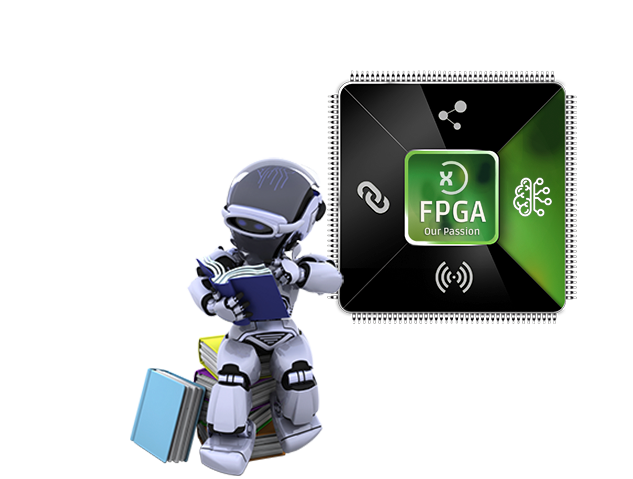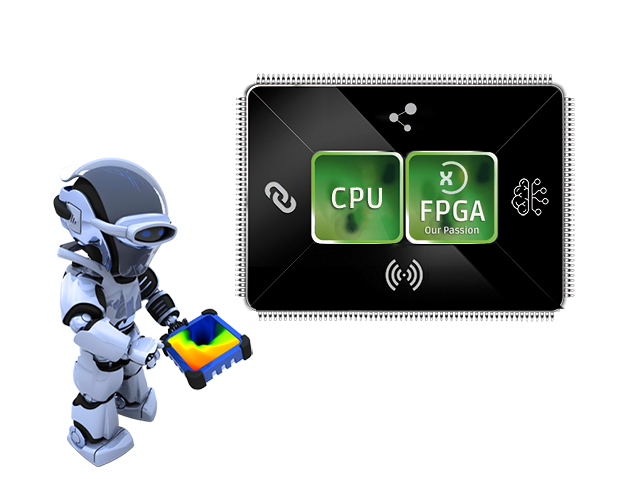We Love FPGAs!
They have been a mainstay of our projects since Solectrix was launched in June 2005. Our development team offers decades of experience working with them and similar programmable logic devices like CPLDs.
We strive to get the best performance out of your system setup and we excel at implementing cutting-edge FPGA technology. Whether we realize particularly complex system configurations or extremely high data throughput requirements, we always welcome a challenge – the more demanding a project, the more our expertise gets to shine.
Since FPGAs are just one element of any system, our services also include hardware design and software integration. If this is what your project requires, we will gladly handle the complete development for turn-key products, making for ideally matched system components.
Our passion for FPGAs is your advantage: Need a reworking of your already implemented FPGA design? Or does your new project require the power of the very latest FPGA models? We work closely with the best FPGA producers in the world, so we are always ready to adapt to your particular requirements.
Digital Signal Processing (DSP)
Image Processing
Algorithm Engineering
Measurement and Control Technologies
High-Performance I/O
High-Speed Serial Connections
PCI Express®
Memory Interfacing
Reliability
Functional Safety
Industrial Networking
Hard Real-Time Systems
Artificial Intelligence (AI)
AI Model Design
Application Development
System Implementation
System-on-a-Chip (SoC)
Smart Vision
Rapid Application Development
High Density Design
Digital Signal Processing (DSP)
Image Processing • Algorithm Engineering • Measurement and Control Technologies
With their immense DSP bandwidth, today’s FPGAs are the obvious choice when large amounts of data need to be processed on the fly. Many complex processing steps can easily be implemented within the same IC, handling the incoming data in parallel or sequentially.
We have put the enormous processing power of FPGAs to good use in the digital imaging field, where they are more useful than ever when it comes to dealing with Ultra HD formats like 4K and 8K. Applications include color pipelines, image enhancement functions and real-time compression for high-end cameras and advanced driver assistance systems.
Our projects also include various complex industrial and medical systems that rely on the versatility and flexible nature of FPGAs. One example would be laser scanning systems, where we have implemented advanced algorithms like Fast Fourier transforms, digital filters, vector calculation and scan field correction as FPGA IP cores.
These laser scanning systems are also an excellent example for many of the measurement and control technologies we have realized via FPGAs: Supervising temperature, pressure, leakage, humidity, scattered light as well as various voltages and currents while controlling moveable mirrors to steer the laser beam and handling various security functions.
High-Performance I/O
High-Speed Serial Connections • PCI Express® • Memory Interfacing
Their increasingly powerful transceivers make FPGAs ideal for applications that require ultra-fast data lines, whether it is for inter-board connection within a system or for its external interfaces.
We have implemented inter-board connections with a performance of up to 75 Gbit/s, utilizing high-speed serial interfaces like PCI Express® 3.x (up to 8 Gbit/s per lane), DXAUI (up to 6.25 Gbit/s per lane), CoaXPress® (up to 6.25 Gbit/s per single cable), SATA Rev. 3 (up to 6 Gbit/s per lane), HD- and 3G-SDI (Serial Digital Interface) and HiSPi™ (High-Speed Serial Pixel Interface).
When it comes to board-internal connections, we have memory interfacing down pat: Our high-end digital camera designs feature DDR3 memory controllers implemented as IP cores. And we are always ready for the next generation!
Going beyond the common industry standards, our FPGA designs have also featured various high-speed interfaces unique to particular sensors. If you are working on a camera system with a brand-new type of sensor, for instance, you can rely on us to take care of the connectivity.
One example for a custom application is our high-speed video streaming framework based on PCI Express®. It can be used to transfer high-quality image data from a camera system to a connected PC which could be part of an existing industrial or medical system that further processes and evaluates the images. The FPGA handles the data transfer to the PC’s memory via DMA (Direct Memory Access) without involving the PC’s CPU.
Reliability
Functional Safety • Industrial Networking • Hard Real-Time Systems
FPGAs are dependable components of countless safety-critical systems, helping achieve functional safety. Examples are supervision of components or ensuring real-time reactions to critical events like leaving a defined safe state.
We have experience with safety-critical applications and the increased data security and latency demands of industrial networking solutions. One example is a custom network interface using Precision Time Protocol (PTP), enabling the synchronization of clocks throughout a system with a clock accuracy in the nanosecond range.
Embedded within our robust hardware designs, FPGAs are well-suited to meet the demands of hard real-time systems that require an immediate response and deterministic behavior. Examples would be dead man’s switches and various watchdog implementations. Bringing both the networking and the real-time aspects together, one of our applications features a customer-specific bus for sensors and actuators with a real-time channel for emergency stop functionality.
Artificial Intelligence (AI)
AI Model Design • Application Development • System Implementation
The parallel processing capabilities of FPGAs make them ideal for AI applications, enabling the analysis of incoming real-time data in a multitude of ways without any delay.
Is it a bird? Is it a plane? It’s probably not Superman for once, but either way, a good image processing AI model should be able to tell. After it has gone through the required learning process, it will perform countless calculations to arrive at a pretty definitive idea of what is contained in an image. The resulting data can be used for applications like Advanced Driver Assistance Systems, constantly scanning camera data for vehicles, pedestrians, traffic signs and road markings.
This type of data analysis requires a lot of processing power, making high-powered desktop PCs with high-end GPUs the platform of choice during the development of the AI model. But on the road, to stick with the Advanced Driver Assistance System example, the physical space and power available for the hardware doing these calculations is very limited. This is where FPGAs have a massive advantage: Their system architecture enables the parallel processing of many image analysis tasks, all implemented on a tiny chip engineered for low power consumption.
Solectrix can handle or assist you with all steps of the AI development process. From setting up a prototype AI for smart data acquisition, guiding the machine learning process, to the eventual compilation of the optimized AI model to an FPGA, the creation of a supplementing embedded application or even the entire embedded system – we are here to help you every step of the way!
System-on-a-Chip (SoC)
Smart Vision • Rapid Application Development • High Density Design
Modern FPGAs have evolved beyond just being advanced logic elements. Some models are available as SoC versions, adding a hard CPU core to the package – examples are the powerful Arm® CPUs in FPGAs from AMD, Intel and Microchip.
We are taking advantage of this combination of FPGA processing power and CPU intelligence in Smart Vision applications like intelligent frame grabbing systems, enabling low-latency access to image data, for example for pattern recognition. Our experience with complete systems ensures that our FPGA designs and the application software for your project are perfectly matched.
While most stand-alone FPGA designs use the established Wishbone bus, we have also developed an AMBA-AXI-based framework for FPGAs with Arm® CPUs, enabling ultra-fast communication between the CPU, the FPGA and the DDR memory. Its flexibility makes it a smart choice for rapid application prototyping.
We like the “complete package” approach of FPGAs with SoC capabilities and their low power consumption, as they make them ideal for our high-density board designs whenever PCB surface area and space for cooling elements are scarce. And by using the standard buses like CAN, I²C, SPI and 1-Wire usually offered by the CPU component, we can save FPGA resources for your project’s specific processing and I/O needs.
And even when a hard CPU core is not available, we have years of experience using various types of soft CPUs implemented as FPGA IP cores. This way we can add intelligence to your FPGA without adding more hardware.
All trademarks are the property of their respective owners.







